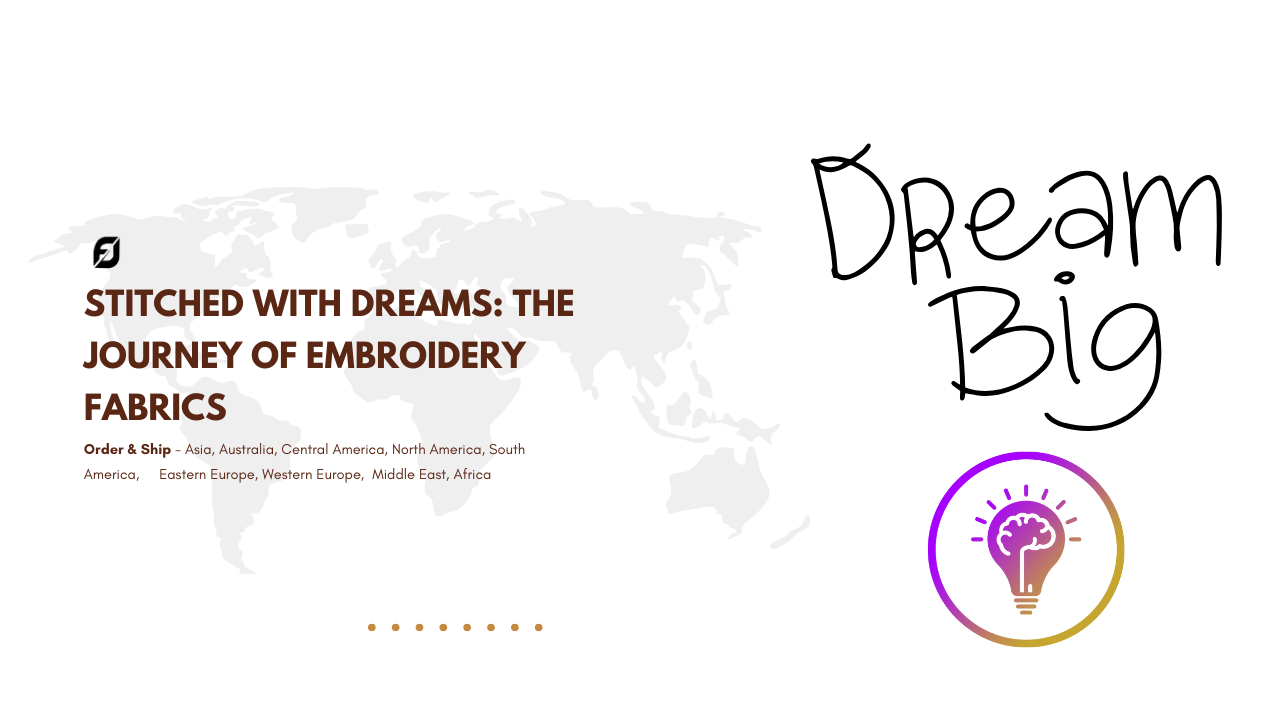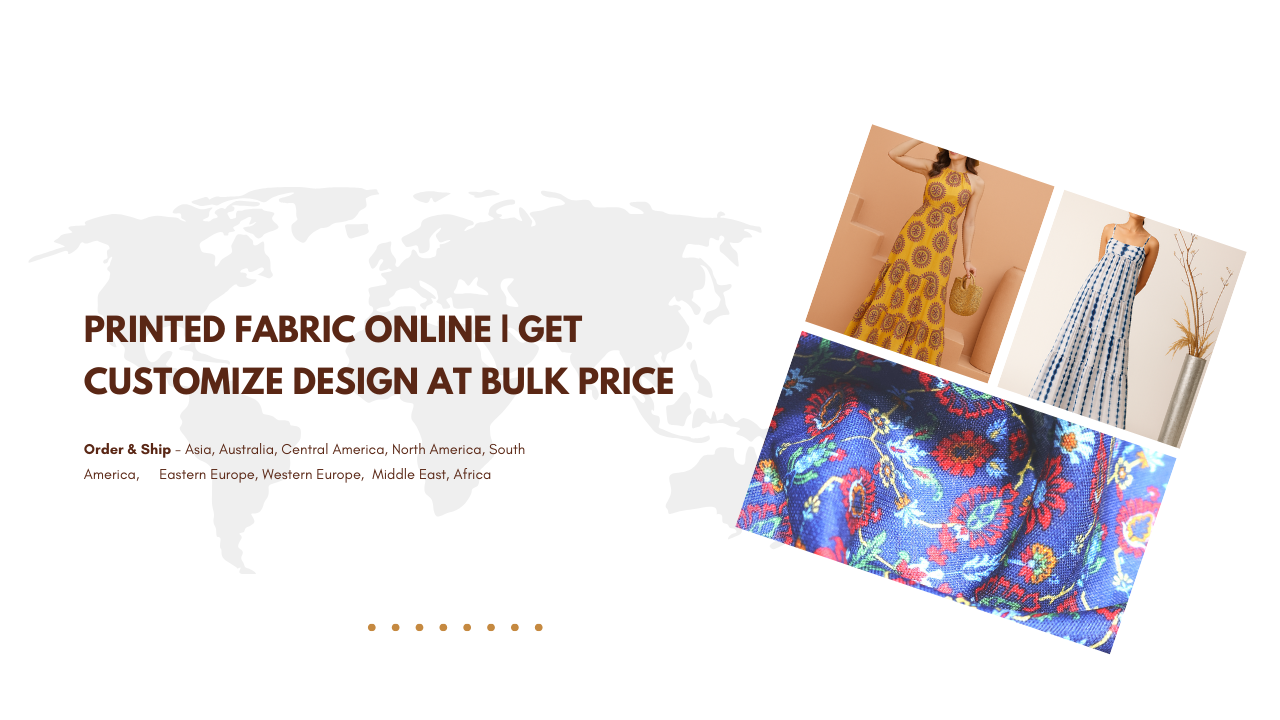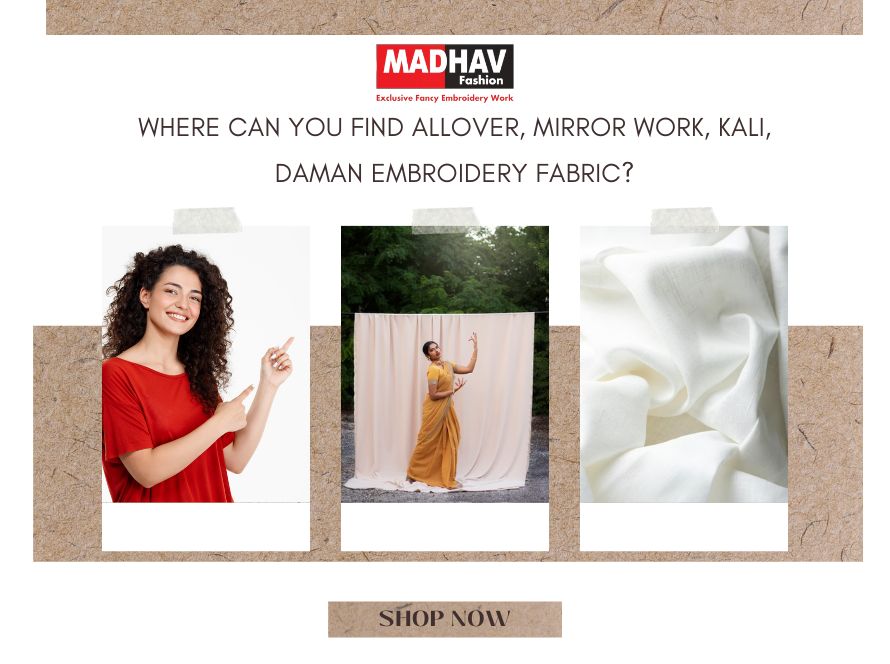Embroidery fabric is a type of textile adorned with intricate designs created using thread or yarn. This fabric is widely used in clothing, home décor, and accessories, adding an artistic touch to various items.
Types of Embroidery Fabric
Embroidery Fabric in Surat: A Comprehensive Guide
Embroidery fabric comes in various types, including:
- Allover Embroidery Fabric: Features embroidery throughout the entire fabric, making it highly attractive.
- Mirror Work Fabric: Incorporates small mirror pieces, enhancing the beauty of the designs.
- Butta and Butti Work Fabric: Decorated with small motifs, giving it a traditional look.
- Sequin Embroidery Fabric: Uses sequins to create a sparkling and glamorous effect.
Best Embroidery Fabric Manufacturers in Surat
Surat is a major textile hub in India, home to several embroidery fabric manufacturers. Some of the best include:
- Madhav Fashion: One of the largest embroidered fabric manufacturers in Asia, known for high-quality embroideryfabrics.
- Other Surat Fabric Manufacturers: Numerous manufacturers in Surat offer a diverse range of embroidery-fabrics.
Where is Embroidery Fabric from Surat Supplied?
Embroidery-fabric from Surat is supplied not only throughout India but also internationally. These fabrics are exported to countries like the Middle East, Europe, America, and Australia, making Surat’s textile industry even stronger.
What is Dyeable Embroidery Fabric?
Dyeable embroidery-fabric can be dyed in various colors, allowing designers to personalize their creations. This type of fabric is beneficial for creating unique pieces by combining dyeing with embroidery.
What Types of Embroidery Fabric Does Madhav Fashion Produce?
Madhav Fashion produces various types of embroidery-fabrics, including:
- Sequin embroidered fabric
- Mirror work fabric
- Allover embroidery-fabric
- Custom designs based on client requirements
These fabrics are known for their high quality and innovative designs.
Why Do People Prefer Madhav Fashion’s Fabrics?
- Quality: The quality of Madhav Fashion’s fabrics makes them stand out in the market.
- Variety: Their product range offers multiple options to meet every customer’s needs.
- Customization: Madhav Fashion offers customization options, allowing designers to choose fabrics based on specific requirements.
- Global Reach: Their fabrics are supplied worldwide, further enhancing the brand’s popularity.
The embroidery fabric industry in Surat, featuring manufacturers like Madhav Fashion, is renowned globally for its quality and diversity. These fabrics have secured a place in both traditional garments and modern fashion, ensuring a constant demand.
__________________________________________
What are the primary uses of Embroidery-Fabric in Surat?
Embroidery-Fabric in Surat serves a multitude of purposes, primarily in the fashion and home décor industries. In clothing, it is used for ethnic wear, bridal garments, and evening dresses, adding a touch of elegance and uniqueness. The intricate designs can elevate simple garments, making them suitable for special occasions. In home décor, embroidery fabric is popular for curtains, cushion covers, and bed linens, enhancing aesthetic appeal and creating a cozy atmosphere.
The versatility of embroidery-fabric allows it to be used in accessories like handbags and scarves, where the added texture and design can make a statement. Additionally, it is often used in craft projects, allowing artists and designers to create personalized items. With its rich variety and availability, embroidery fabric caters to different tastes and preferences, making it a favorite among designers and consumers alike.
What types of embroidery techniques are commonly used in Surat?
In Surat, several embroidery techniques are popular, each offering unique aesthetics and styles. One of the most common techniques is Zardosi, which involves intricate gold and silver thread work, often used in bridal and formal garments. Resham work, using colorful silk threads, adds vibrancy and richness to fabrics, making it a favorite for festive wear.
Mirror work is another prominent technique, featuring small mirrors sewn onto the fabric, creating a dazzling effect. Appliqué, where one fabric is stitched onto another, is also popular for creating layered designs. Tikka and kantha stitching are traditional techniques that add texture and depth to embroidery fabric. Each of these techniques reflects the rich cultural heritage of India, allowing artisans to showcase their craftsmanship and creativity. The choice of technique often depends on the intended use of the fabric, the desired aesthetic, and current fashion trends.
How can one identify high-quality embroidery fabric?
Identifying high-quality embroidery fabric involves several factors. First, examine the thread count and fabric weight; higher thread counts often indicate better quality. The feel of the fabric is crucial; it should be soft yet durable, with no rough patches or inconsistencies. Inspect the embroidery work itself—high-quality embroidery will have even stitches, clear designs, and no loose threads.
Colorfastness is another important aspect; quality fabrics should not bleed colors when washed. Additionally, check for fabric finish; it should have a smooth surface without any imperfections. If possible, inquire about the manufacturing process and materials used; natural fibers like cotton or silk are often preferable to synthetic ones. Lastly, consider the manufacturer’s reputation; established brands, like Madhav Fashion, often adhere to higher quality standards, ensuring customer satisfaction.
What makes Madhav Fashion stand out among other manufacturers?
Madhav Fashion distinguishes itself through a combination of quality, innovation, and customer focus. As one of the largest embroidered fabric manufacturers in Asia, they prioritize high-quality materials and craftsmanship. Their diverse product range caters to various customer needs, from traditional designs to contemporary styles. Madhav Fashion’s commitment to sustainability also sets it apart; they use eco-friendly practices in sourcing and production.
Moreover, their emphasis on customization allows designers to create unique pieces tailored to their specifications. The company also invests in research and development to stay ahead of trends and introduce new techniques and designs. Customer satisfaction is paramount; their responsive customer service ensures that inquiries and issues are addressed promptly. By blending tradition with modernity and maintaining high standards, Madhav Fashion has garnered a loyal customer base, making it a trusted name in the embroidery fabric industry.
How is embroidery fabric manufactured?
The manufacturing process of embroidery fabric involves several steps, beginning with the selection of high-quality base fabric, such as cotton, silk, or polyester. Once the fabric is chosen, it undergoes a pre-treatment process to ensure it is clean and ready for embroidery. Next, a design is created, either digitally or by hand, which is then transferred to the fabric. The embroidery process can be executed using different methods, such as machine embroidery or hand embroidery, depending on the desired effect.
In machine embroidery, computerized machines stitch the design onto the fabric with precision. For hand embroidery, skilled artisans meticulously stitch each design, adding a personal touch. After the embroidery is complete, the fabric is inspected for quality, with any defects corrected. Finally, the fabric is dyed or finished, depending on the specifications. This intricate process ensures that each piece of embroidery fabric meets high-quality standards and showcases exquisite craftsmanship.
What is the difference between machine and hand embroidery?
Machine embroidery and hand embroidery are two distinct methods of applying designs to fabric, each with its unique characteristics. Machine embroidery involves using computerized sewing machines to stitch designs onto fabric. This method is often faster and more precise, allowing for intricate designs and consistent quality across large quantities. It is ideal for commercial production where time efficiency is essential.
In contrast, hand embroidery is performed manually by skilled artisans, making each piece unique. This method allows for more creativity and personal expression, as artisans can adjust designs on the fly and add intricate details that machines may not replicate. Hand embroidery typically takes longer and may be more costly, reflecting the craftsmanship involved. While machine embroidery is great for bulk orders, hand embroidery is often preferred for one-of-a-kind pieces, such as bespoke garments or artisanal home décor items, where the value of craftsmanship and uniqueness is highly regarded.
Can embroidery fabric be used for various types of clothing?
Yes, embroidery fabric is incredibly versatile and can be used for various types of clothing. It is particularly popular in traditional and ethnic wear, such as sarees, lehengas, kurtas, and salwar suits. The intricate designs enhance the aesthetic appeal of these garments, making them suitable for festive occasions and weddings.
Additionally, embroidery fabric is increasingly being used in contemporary fashion, including dresses, blouses, and even casual wear, where it adds a unique touch. Designers often experiment with embroidery fabric to create statement pieces that stand out. Moreover, embroidery can be combined with different fabric types, such as chiffon, silk, or cotton, allowing for creative layering and textures. This adaptability means that embroidery fabric can cater to various fashion trends, from vintage to modern styles, making it a favored choice among designers and consumers alike.
What are the latest trends in embroidery fabric?
The world of embroidery fabric is constantly evolving, with new trends emerging regularly. Currently, sustainable fabrics are gaining popularity, as consumers become more conscious of environmental impact. Manufacturers are incorporating eco-friendly materials and dyes in their production processes. Another trend is mixing textures; combining embroidery with different fabrics, like mesh or leather, creates visually striking garments.
Bold colors and oversized patterns are also on the rise, as designers move away from traditional pastels and embrace vibrant hues and large-scale motifs. Additionally, 3D embroidery techniques, which create raised designs, are becoming increasingly popular for adding depth and dimension to fabrics. Customization is another significant trend, with consumers seeking unique, personalized pieces that reflect their individual styles. As fashion continues to evolve, embroidery fabric will remain a dynamic element, adapting to these trends while maintaining its rich cultural heritage.
How do I care for embroidery fabric to maintain its quality?
Caring for embroidery fabric is essential to preserve its quality and longevity. First, always check the care label for specific instructions related to washing and drying. Generally, it’s advisable to hand wash embroidery fabric in cold water with a gentle detergent, as machine washing may cause wear and tear. Avoid wringing out the fabric; instead, gently press it between two towels to remove excess water.
If machine washing is necessary, use a delicate cycle and place the fabric in a mesh laundry bag to protect the embroidery. Air drying is preferable; hang the fabric in a shaded area to avoid direct sunlight, which can fade colors. For ironing, use a low heat setting and place a cotton cloth over the embroidery to prevent direct contact. Regularly inspect the fabric for loose threads and promptly repair any damage to maintain its beauty. Following these care tips will help ensure your embroidery fabric remains vibrant and intact for years to come.






